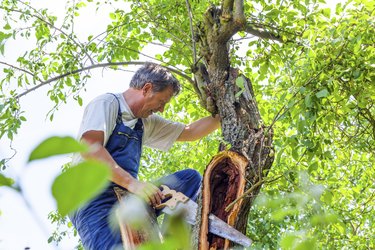
The best tool for cutting tree branches depends on the size of the branches and whether they are living or dead. Several tools make the job of pruning easier than other tools do. Hand pruners, loppers, pole pruners and saws all have their place in helping you shape and care for trees.
Hand Pruners
Video of the Day

Hand pruners cut living branches that are less than 3/4 inch in diameter and, compared to larger shears, will allow you better maneuverability among crowded branches. Hand pruners can handle branches only as wide as 1/2 inch, however, if the wood is dead because dead wood is harder to cut than live wood. Two variations of hand pruners are available: anvil pruners and bypass pruners. Anvil pruners are easier to use on hard wood but can crush living branches rather than making clean cuts. Therefore, bypass pruners are recommended despite their extra cost.
Video of the Day
Lopping Shears

Lopping shears, referred to as loppers, can cut branches as big as 1 1/2 to 2 inches in diameter, depending on the tool's specific model. Two hands are used to operate loppers, which have long handles that provide the extra leverage needed to cut the branches they can tackle. Loppers also may have extendable handles and joints powered by ratchets or gears that make reaching and cutting large branches easier. Some models have shock-absorbing features that reduce operator fatigue when cutting large numbers of branches.
Pole Pruners

Like loppers, pole pruners cut branches as much as 1 1/2 to 2 inches in diameter but are attached to extendable poles so can be used to cut branches that are out of the reach of normal loppers. Spring-loaded blades are operated with a rope or cord that runs the length of a pole pruner's pole. Many pole pruners also have a small, attached pruning saw for use on branches too big for the spring-loaded blades. Select a pole pruner made of a lightweight material, such as fiberglass or aluminum, so you can easily control the tool when you lift it over your head.
Pruning Saws and Chain Saws

Hand-held pruning saws cut branches that are up to 3 inches in diameter. Collapsible models are easily carried in a pocket, but using the tools to saw completely through large branches can take a lot of time. Chain saws are used to cut branches 3 inches in diameter and larger. They cut much faster than hand-held pruning saws but are more dangerous to use because of the risk of injury they pose. A chain saw's power, however, makes cutting large tree branches with the tool practical when completing the task with a hand-held pruning saw would take too much effort or time.